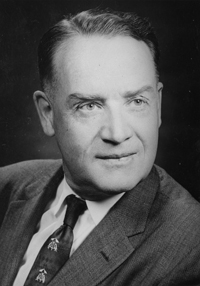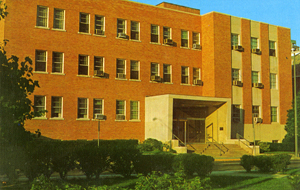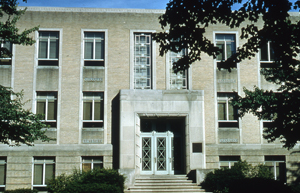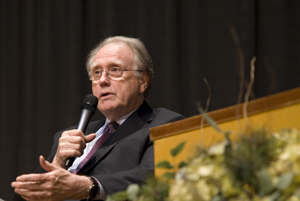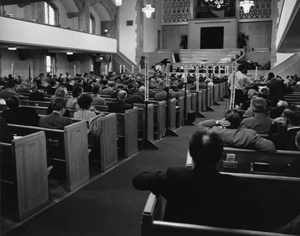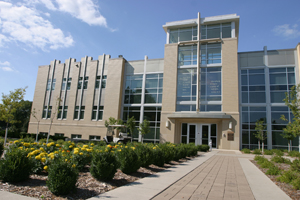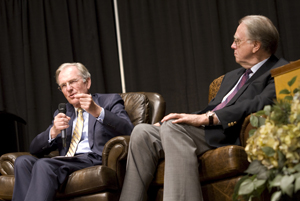Contact: pr@andrews.edu
Website:
Phone:
Originally published in the Oct. issue of the Lake Union Herald
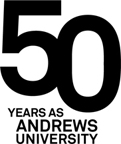
When the General Conference Autumn Council convened in October of 1958, perhaps no one fully knew how people, institutions and the Church itself were going to be changed and affected by the discussions that ensued and the decisions the delegates made. The attendees were about to witness the birth of a new university, a comprehensive university to serve the world church. It would be a long process culminating in the naming of Andrews University in April of 1960, but it began that October day. Three institutions in particular would never be the same again: Emmanuel Missionary College, the Seventh-day Adventist Theological Seminary and Potomac University.*
Emmanuel Missionary College
In 1958, Emmanuel Missionary College had been in Berrien Springs for 57 years. The school resided on about 400 acres, which included “rich farm land,” in what then-President Floyd O. Rittenhouse referred to as a “favored rural region.” Recent building achievements included a “modern, efficient milking parlor,” and plans were underway for a new student center that would include new, updated dining services. It would be the first change in the cafeteria accommodations since the dining room was installed in the basement of the women’s dormitory in 1901. The campus was also abuzz with the near-completion of a brand new college church, rising on the southern edge of campus. The Library housed a collection of 60,000 books, but was quickly outgrowing its home in what is today known as Griggs Hall. Of the dedicated faculty, 16 had doctorates and 40 held masters’ degrees.
In spite of its rural setting and the apparent slow pace of EMC’s campus life, President Rittenhouse noted, “Our campus far more closely resembles an ant hill than a calm and quiet retreat.” **
|
|
| President Floyd O. Rittenhouse served as president during the tumultuous transition from EMC to Andrews University (1955-1963). |
In the fall of 1958, 929 students representing 23 countries were enrolled in the college. The student body reveled in the typical round of collegiate activities: the student paper, the yearbook, campus clubs, Ingathering, MV bands, American Temperance Society orations, singing in the Collegians or playing in the EMC concert band, the SA banquet, the lyceum-concert series on Saturday nights, and so on. In addition to pursuing a rich extracurricular life and their studies the students worked all over campus—at the bindery, laundry, farm, college press and service station, to name just a few. Rittenhouse boasted that they earned over half a million dollars in their on-campus work.
And the world crept into the peaceful setting, as it always had. Rittenhouse reminded the constituency of the Lake Union that the campus was not completely isolated: “Influences of the cold war, the struggle over integration, labor difficulties, the decline of public and private morality, the portents of radically differing patterns of society under the aegis of nuclear science and the space age, the competition for students on the part of well-financed, tax-supported colleges—all these things affect us.”
The Seminary
Several hundred miles to the east, the Seventh-day Adventist Theological Seminary had been established for the past 23 years near the hub of the nation in Takoma Park, Md. A new Seminary building was dedicated in January of 1941, built on a lot behind the General Conference, but by 1957 it was already overflowing. Built for a maximum enrollment of 140, it was trying to accommodate around 200 students from 13 countries. Classes were being held in the chapel and in the Takoma Park church. The carefully selected theological library, cared for by Mary Jane Mitchell, held an impressive 43,000 volumes. It, too, was overflowing.
In 1958 there was an influx of “fifth-year” ministerial students who were completing their extra year of training after college (a new church-wide requirement), but a majority of the students were mature church workers, many of them ordained, who had already served in the field and had returned for graduate training. They were serious students hungry for more intellectual and spiritual underpinnings on which to build their ministry. Many were married and had families. The Seminary owned 83 apartments where the students lived. Still, many were struggling to make ends meet and worked at a wide variety of jobs throughout the urban area.
|
|
| World headquarters of the General Conference of Seventh-day Adventists, shown here in 1964. |
Elder Jan Paulsen, current president of the General Conference, shared his personal experiences during an August, 2009 visit to the campus of Andrews University. Paulsen holds degrees from Emmanuel Missionary College, the Theological Seminary in Takoma Park, Md., and Andrews University—uniquely positioning him to remember the times of decision and change that led to the creation and formation of Andrews University in 1959. After graduating from EMC in 1957, he went to the D.C. area and spent two years in the Seminary. He completed his master’s degree at Potomac University and returned to Europe, with intentions to complete his final year of Seminary at some point in the near future.
Jan Paulsen was just 22-years-old when he began his education at the Seminary in Takoma Park. From 11 p.m. to 7 a.m., he worked as a night watchman at the General Conference, making rounds and doing a little janitorial work as well: “I had one section of the building that I had to clean every night. I’ll tell you: there is an enormous amount of education in wastebaskets. And that’s where I began my service for the General Conference.” ***
Paulsen remembers the two very distinct “flavors” of the seminary experience in the D.C. area versus his experience in Berrien Springs. There, many seminarians were missionaries on furlough. It was quite common for missionaries to use their furlough as a chance to complete their graduate work. “That put a very specific flavor—it’s difficult to describe—but it’s a down-to-earth type spirituality,” says Paulsen. “It’s not a classroom spirituality. They had been working in a multicultural, real-world experience and they brought that reality into the classroom with them.”
The actual location of the Seminary, adjacent to the General Conference, was of great importance to Paulsen’s experience: “We ate in the Review & Herald cafeteria if we wanted to. Many of the GC people were also there eating. We worshipped in the same churches. Some of the GC people would come and teach the classes. The aura of being close to the GC was impactful on me.”
Potomac University
In 1955, the General Conference had undertaken the issue of expanding advanced study in the denomination by forming the Committee on Graduate Work. The Church—both in North America and worldwide—desperately needed educators with advanced degrees in its secondary schools and colleges. The result of the Committee’s research and deliberations was a decision made at the 1956 Annual Council to establish a university that would consist of “an organic union of the Seventh-day Adventist Theological Seminary and a new graduate school,” as well as an “affiliation with Washington Missionary College as the undergraduate institution.” Elder E.D. Dick, then-president of the Seventh-day Adventist Theological Seminary, was asked to serve as acting president of the new entity, which would be called Potomac University. W.H. Beaven, the dean, began to develop graduate programs in religion, history and education, and made plans for degrees in English, music and biology as soon as finances permitted.
|
|
| Potomac University was founded following a decision to establish a university that would consist of “an organic union of the Seventh-day Adventist Theological Seminary and a new graduate school,” as well as an “affiliation with Washington Missionary College as the undergraduate institution.” |
Then the wrangling over the location of the new university began. There was no extra room on the cramped campus of WMC or at the Seminary. Would the University stay in Takoma Park, with new facilities to be built on 18 acres next to Takoma Academy? Would the whole school move out of the city? There were disagreements among church leadership as to the next step.
In June of 1958, the trustees decided to call a new president to Potomac University: Floyd O. Rittenhouse, president of Emmanuel Missionary College in Berrien Springs, Mich. With some reluctance and a good deal of arm-twisting from the church headquarters, Rittenhouse accepted and began a double life of serving as president to both EMC and Potomac University until a replacement could be found for his duties in Berrien Springs.
Rittenhouse liked to say that during that stressful period he commuted by night and worked by day. Known for having a frank sense of humor combined with a quick wit, Rittenhouse was well-known for his quips. Greg Constantine, research professor of art and artist-in-residence emeritus, and a student at EMC/Andrews University from 1955 to 1960, recalls one of the president’s memorable pieces of advice to the students: “One of the things he liked to say was, ‘The door that let you in will also let you out.’”
Rittenhouse had agreed to be president of Potomac University contingent upon the understanding that all three institutions—Washington Missionary College, the Seminary and the graduate school—would be integrated. Elder R.R. Figuhr, General Conference president at that time, had assured him that that would be the case. At that time, Rittenhouse had no other thought than that the new combined university would be located in the Washington area.
Rittenhouse, along with the rest of the search committee, set their attention on finding a location to build this new university in the greater D.C. area. They found a parcel of property—not far from what is today the location of the General Conference headquarters—and paid down an option with intentions to build the new integrated school there.
“I worked night and day, early and late, trying to get a decision to build the new institution there,” said Rittenhouse. “But I soon discovered Columbia Union Conference was very hesitant to move Washington Missionary College.” Money was the culprit. Church leadership felt they did not have sufficient funds to build the new institution and soon politics set in. Eventually, according to Rittenhouse, the entire proposal—the bringing together of the graduate school, the Seminary and Washington Missionary College—fell apart over the issue of .25 percent interest on a loan.
Autumn Council 1958
Things came to a head in October of 1958. Rittenhouse wrote to Figuhr, just days before Autumn Council began. In that letter he wrote, “Now these developments clearly indicate that the university as outlined to me does not now seem to be either in the immediate or remote prospect. Thus, the post which I thought I was to have, does not now exist nor does it appear likely to exist anytime in the near future. I do not feel that I would fit very well in the Seminary as such by itself….Under these circumstances I feel that I am left no choice but to bow out of the picture….I plan to be in Washington next week for a few days of the Autumn Council, but I cannot stay long.”
Back in Berrien Springs, most at the EMC campus were very unhappy Rittenhouse was leaving. There was apparently a movement afoot, starting almost immediately after he accepted the Potomac University position, to argue for the newly-combined university to be located in Berrien Springs. Edwin R. Thiele, long-time religion teacher at EMC, admitted in a letter: “I was intensely interested in the location of the university at Berrien Springs right from the first, and did everything I could toward that end.”
Discussion about the university began on Thursday morning, Oct. 23. Only 175 in the Council had voting privileges, but the Takoma Park Church was packed with about 500 people. Elder Figuhr made the first public announcement to the assembly that there was a proposal to move the university to Berrien Springs. So many people wanted to speak to the issue that the discussion continued all afternoon and resumed again on Friday morning.
Rittenhouse later recalled of the Autumn Council, “By that time, the Lake Union had decided maybe they should make a plea to have the graduate program moved to EMC. Not having really thought it through thoroughly, but with a hasty decision, Elder J.D. Smith, president of the Lake Union Conference, stood up and said, ‘We’d like to offer the graduate program 40 acres of free land if you’ll come to join [us with] EMC as the undergraduate part of the institution. You can bring the seminary and the graduate school here to Berrien Springs.’”
Then the arguments began. For two days, the Council discussed it from every standpoint. Rittenhouse recalled one individual’s opposition to the Berrien Springs location: “‘What’s the use of taking a great educational institution and putting it down in the middle of a tomato patch?’”
Advocates for remaining in the D.C. area cited the benefits of having the graduate and seminary programs situated near a mental institution where students could go to study all kinds of mental deviation. That excuse didn’t hold weight for Rittenhouse and he quickly noted the proximity of a mental institution in Kalamazoo.
|
|
| Jan Paulsen, president of the Seventh-day Adventist World Church, answers questions about Adventist education at the "Rethinking Education" vespers during the annual Fall Fellowship. |
Over the course of Autumn Council, Rittenhouse made a number of speeches. At this point, he was clearly advocating for a move to Berrien Springs. Charles Weniger was emphatic about the advantages of being in a cultural center like D.C., with access to the Library of Congress, and at the center of the Seventh-day Adventist power structure. Rittenhouse couldn’t argue with the proximity to the Library of Congress, but made an astute argument against it. Elaine Giddings, long-time professor of communication at Andrews University, recalled, “Rittenhouse said he had been talking to six or seven seminary students and not a single one had ever seen inside the Library of Congress. Winton Beaven told me it was one of the most effective—if not the most effective speeches—he had ever heard.”
Paulsen remembers that particular debate, “Two or three times during my study in Washington, D.C., I did, in fact, go to the Library of Congress but I never thought that was a serious argument.”
Leona Running, who was then a faculty member at the Seminary in Takoma Park but also a Michigan native and alumna of EMC, said, “Several of the people that made speeches in the debate…talked about the need for a rural location and following Mrs. White’s advice. They were very much astonished afterward to find out they had been understood as supporting the move to Michigan. They had meant to support the move to the countryside [in D.C.].”
Some of the misunderstanding that day may have been caused by events that took place before the meetings in Takoma Park. A campaign had been mounted during the summer to bring the university to Michigan. An unsigned, anonymous memorandum circulated through the summer months arguing for the university to be moved out of the D.C. area. It didn’t name Berrien Springs specifically, but it collected a number of quotations from Ellen White about how denominational schools should be established in rural areas. It also argued, with the late 1950s consciousness of the Cold War, that if there were to be atomic warfare, Washington D.C. would be one of the first targets in the United States. It implied that a university located even within 25 to 30 miles of the capital city, would not be safe enough. It began to be clear that the idea of relocating to Berrien Springs was gaining ground.
|
|
| At the Autumn Council, the Takoma Park Church was packed with about 500 people, but only 175 had voting privileges. (Photo circa 1960) |
Once the Columbia Union realized a move to Berrien Springs was quite possible, they also realized the impact that losing the tithe of seminary students, faculty and staff would have on their budget, according to Rittenhouse’s account. They went to Elder Figuhr and asked for a decision to be postponed to give them time to reconsider. Rittenhouse remembered that Elder Figuhr’s “dander was up,” and he said, “Absolutely not. You had your chance. Before we adjourn tonight, the decision is going to be made.”
Rittenhouse had a speaking appointment at EMC back in Berrien Springs, so he had to leave Takoma Park early, before a final decision was made.
“I didn’t know what the decision would be,” said Rittenhouse. “I only knew I was in terrible mental turmoil and perplexity because I was so disappointed that we couldn’t have gone out towards Columbia on that spot. That would have answered a lot of the objections and would have been a new place to begin all over again, but because of the lack of vision on behalf of the people in the Columbia Union and because the General Conference was not willing to give more time to consider it. I came home that night by plane, and when I reached home the telephone rang. It was a message that they had voted 3-1 to come to Berrien Springs. Now, I’ll tell you: that was the beginning of tribulation as far as I was concerned.”
Leona Running, professor emerita of the Seventh-day Adventist Theological Seminary, was in the balcony of the Takoma Park Church during the Autumn Council. When the decision was finally made, she was dumbstruck: “We were just numb. What about access to the Library of Congress and the other libraries in the area? What about all the jobs our students and their families had access to in that area? Would there be anything comparable up in Michigan? What about all the churches the students went to for the Sabbath sermon practicums? The churches in Michigan would entail much more travel and expense,” says Running. “There were just all kinds of problems that we saw, not the least of which was three or four faculty members had just built lovely new homes out in the countryside in the area where they thought the school might move to.”
“The sentiments Dr. Runnings expressed was what the teachers felt and it filtered through into statements they made to the class,” says Paulsen. “There was a general sense of dismay and anger. They felt a coup had been made. They felt this was a day of real gloom that the church had made this decision.”
Andrews University
Nonetheless, the decision had been made. People and places in Maryland and Michigan felt the immediate impact, but the decision would have repercussions throughout the world of the Seventh-day Adventist Church for years to come.
And now that this newly-combined institution was underway, a new name was needed. A Potomac University in Berrien Springs, Mich., did not seem to make much sense. In April 1959, the Board voted the name Lake Michigan University but the EMC campus rose up in protest. The name was all about location, they said, and told nothing about the nature of the school or its mission. They argued that the alumni and the constituency would not be happy.
A number of possible names were suggested and discussed: Lake Central University, Lake Arbor University, Pioneer Memorial University, Griggs University, Farnsworth University and Emmanuel University. Two strong possibilities were Maranatha University and J.N. Andrews University.
|
|
| Enrollment at the recently expanded Seventh-day Adventist Theological Seminary has steadily increased with the support of the worldwide church. Graduates of the Seminary serve at every level of Church leadership around the world, from Jan Paulsen, president of the General Conference, to local churches in every division. |
Rittenhouse preferred Maranatha University: “I liked the sound of it and it means, ‘The Lord is coming’.” But when it came to the board, some thought it sounded too “highfalutin.” The name lost by three votes. And that is how Andrews University got its name, a tribute to a dedicated scholar and the first official missionary of the Seventh-day Adventists church to serve outside of North America.
Choosing a name didn’t solve the angst felt in the community. Rittenhouse later reported that some of the faculty members [at EMC] said we don’t know what we’re up against. And Rittenhouse told them, “I can tell you: we’re up against a revolution. That’s what’s going to happen. This institution will never be the same again. And it will be a fine opportunity to serve. The objectives are the same and I believe it’s under God’s providence that we came here.”
Niels-Erik Andreasen, president of Andrews University, remembers the old-timers at EMC were not so happy about the newcomers living in fine brick houses on University Boulevard or that faculty in the seminary had one full-time secretary for every two teachers. “I remember thinking, ‘Is this ever going to be one university?’”
Education as a Defining Factor
Two years before Andrews University was born, the book Questions on Doctrine was published. It was a response to the question asked of the Seventh-day Adventist church: Is it a Christian church or a religious sect? “That had been asked in the 1950s, I believe, and the book was written to answer those questions. The answer was: we are a church,” says Andreasen.
“One of the things that distinguishes a church from a religious sect is education. I’ve often wondered if a historian could figure out if there is a relationship between making that decision about our church by the administration of R.R. Figuhr and then by the same administration making a decision that the university should be built with an undergraduate, a graduate and a seminary faculty. So the intriguing question is: Does a Christian church that has defined itself that way also feel compelled to start a university, a real university? Which is what Andrews was intended to be. The more I hear the dialogue, the more I think the answer is yes,” says Andreasen.
|
|
| From left: Niels-Erik Andreasen, president of Andrews University, and Jan Paulsen, president of the Seventh-day Adventist World Church, answer questions about Adventist education during the "Rethinking Education" vespers held during the annual Fall Fellowship. This year Andrews University celebrates 50 years. |
“These people thought a real Christian church who wants to get rid of the sectarian connotations wants to embrace a university where Christian faith and Christian thinking and theology is informed by theologians, seminary teachers and missionaries returning from the field,” says Andreasen. “Our mission is to see to it that our church is a strong Christian church in the world, something we know cannot happen without a commitment to Seventh-day Adventist Christian education.”
Rittenhouse’s vision at the dawn of Andrews University placed the institution at the helm of Seventh-day Adventist education. “We have the benefit now of being able to look back on the period of several decades. We can clearly see the experience we’ve gained and look at the service that has been provided by the institution, how it has responded to the needs of the church and done so in a wonderful manner,” says Paulsen. “We have been blessed.”
-Written by Meredith Jones Gray, professor of English and Andrews University campus historian, and Keri Suarez, media relations specialist, Office of Integrated Marketing & Communication
*The background information for this article was taken from primary documents—minutes, letters and transcripts of reports—in the General Conference Archives and the Center for Adventist Research.
**Comments by Drs. Rittenhouse, Running and Giddings were made in a panel discussion entitled “The Birth of Andrews University,” held on May 14, 1988. It was recorded on videotape.
***Remarks by Greg Constantine, Jan Paulsen and Niels-Erik Andreasen are taken from an interview conducted by Brent Geraty on August 14, 2009, for the vespers program of Fall Fellowship at Andrews University in celebration of 50 Years as Andrews University. Since the decisions of 1958-1959, Andrews University has served as educational servant to the world church and a General Conference institution.
